2016 Jan-June
One Take on TV
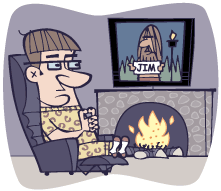
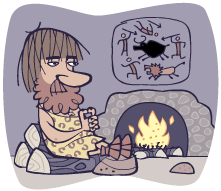
Has TV made us lazy and stupid? That we’ve become a species of sedentary sloths listlessly goggling our TV screens at the expense of all else seems to be accepted as obviously true. Is it? This assumes two things: One, if there were no TV people would be doing something active; Two, before there was TV people were more active in their leisure hours.
What were people doing in their spare time that was all so very active before the gamma ray mesmerizer invaded our homes? For one, they listened to the radio. Unlike many folks today, they didn’t do this while jogging. Radios then were the size of a microwave tethered to the wall jam-packed with glowing hot vacuum tubes, so they listened nestled in comfy chairs and on couches. They also went to the movies which then, as now, involved a lot of good old sitting.
What did they do before radio and movies? Well, they read books and periodicals, wrote letters, knitted, did needlepoint, played piano, attended lectures and performances, collected stamps, whittled, chatted on the front porch or parlor, played checkers, chess, dominoes and cards, smoked, and drank a lot. Pretty much all sitting down. Chairs and lounging in them are hardly a new phenomenon. Besides, don’t they also say the pace of life in the olden days was slower?
Can you imagine cavemen after a day’s hunting and gathering doing sit-ups, pilates, or jazzercizing? The idea of running to go nowhere probably would smack your average caveman as the height of absurdity. Has TV really turned us into tube tubers, or simply given us something different to do in our off hours when we’d be loafing around anyway? I wonder.
Nobody really knows how active folks were in the past, but the English compared kids in rich schools with lots of extracurricular activity to kids in poor districts offering little. They found no difference in total activity, kids found things to do regardless of their environment. Maybe folks are as active or inactive as they want to be, whether there’s something on TV or not.
As for TV making us stupid, yes.
Filed 6/17/16
The Casual Sportsman
Hitting a Fastball Should Be Impossible
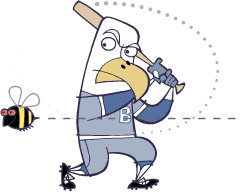
Your typical major league ballplayer has 20/12 vision. OK, what’s that 20/20 vision business mean anyway?, I hear myself asking. It means a person can see clearly something at twenty feet that is normally seen clearly at twenty feet. 20/12 means something at twenty feet is as seen as clearly as something at 12 feet. Big league hitters have the proverbial eagle eye.
Though an eagle is estimated to have 20/4 vision. Plus they have big-time magnification in their lenses, but we’re getting off track.
So, does 20/12 vision help hit a fastball? Maybe, maybe not. Some ballplayers wear contacts. Anyway, the amazing thing about hitting a 90+ mph fastball is the amount of time a batter has to see, decide, swing and make contact to drive the ball into fair territory. Actually, how little time they have, about the literal blink of an eye. Incredibly, major leaguers can often place their hits, which one guesses takes micro-second timing.
Hitting a Major League fastball should be physically impossible - a short video
Of course, scientists also used to say bumblebees shouldn’t be able to fly. Now then, what’s the batting percentage of scientists?
Filed 5/16/16
Fresh Clichés by the Dozen
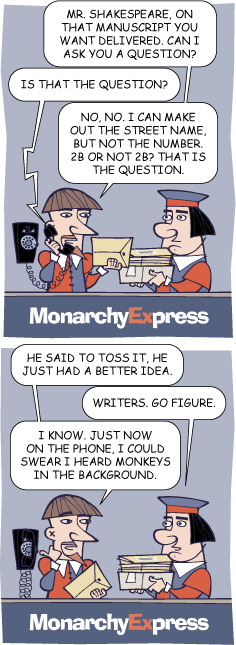
Alas, poor Yorick. Wherefore art thou Romeo. To be, or not to be. It’s easy to spot many a quote from old Willie Shakespeare. Other coinages have worked their way into the language to the point we aren’t aware they came from the Bard of Avon. All the same, who knows if he made them up or was simply glomming ye olde slang of the day?
Filed 4/13/16
Suck.com Comics Spoof Redux Two
And now for something slightly different.
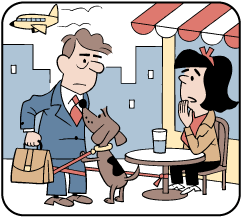
Find at least six differences in details between panels.

Mouseover for answers
Differences: 1. Woman is identical twin sister. 2. Man has whisky bottle in briefcase instead of papers. 3. Airplane is en route to Kennedy instead of LaGuardia. 4. Man is wearing Armani suit instead of Zenga. 5. Glass is half empty instead of half full. 6. Dog has been spayed.
Filed 4/12/16
Suck.com Comics Spoof Rerun One
I didn’t just draw cartoons for the old e-rag, I helped write content from time to time. Whether that actually helped is for the reader to decide.
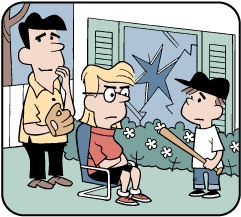
Find at least six differences in details between panels.
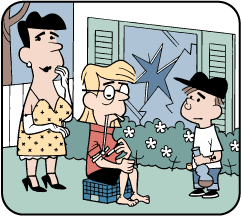
Mouseover for answers
Differences: 1. Man’s shoes are different color. 2. Boy’s arm is repositioned. 3. Woman’s bangs are longer. 4. Blossoms are different. 5. Grass is greener. 6. Boy is less worried.
One little update, that’s Bruce Jender, gold medal biathlete.
Filed 4/11/16
The Casual Sportsman
Rhymes with P and That Stands for Billiards
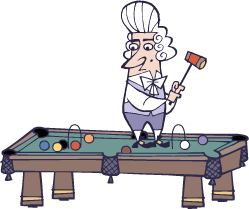
Billiards was first played with mallets instead of cues. It was sort-of like table croquet. The trouble with that was when the cue ball was frozen to the rail they couldn’t get the mallet head on it. In which case the shooter would poke it with the mallet’s handle end, called the queue in French. These days we dispense with the mallet head and use a long handle with a bit of leather on the end, which we call a cue.
Why is it called both billiards and pool? The billiards name came first. Pool comes from the venue where the tables started showing up for public use: betting parlors. You’re likely familiar with football pools or similar betting schemes. Pools are a common way to bet and old betting shops were called pool halls or pool parlors. These put in billiards tables for the betting clientele who started calling them pool tables. Eventually the game played on them became pool. Gambling and pool have gone together a long time.
Filed 4/8/16
One Step beyond the Outer Limits of the Twilight Zone
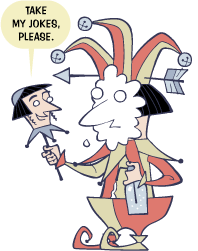
The above Suck.com illo rerun leads us into the topic du jour: the most dangerous day of the year, news and rumor-wise. April Fools Day. On this date in years gone by many people have been burned repeating nonsense written as spoofs as being true. Is it because people are gullible? Is it because authors don’t know how to write parodies that are, you know, actually funny? Or is it because real news and people have become so absurd a spoof seems all too real?
Have we finally breached the Parody Horizon? An imaginary boundary where satire can’t surpass actuality which is already absurd beyond belief, though people believe it anyway. A singularity of infinitely dense thinking, a comedic black hole where the line between sensible and ridiculous vanishes.
Can you say, modern art? How about negative interest rates? It seems April Fools Day never ends. Maybe Abe Lincoln was wrong. Maybe you can fool all of the people all of the time. Or at least enough of the people enough of the time to make a lot of money.
Filed 4/1/16
Bubble Cars Return (Sort-of)

If bubble cars, a la the 1950s, are not poised for a big comeback, how about bubble motorcycles instead? Bubble cars must comply with the safety standards applied to all cars. That adds cost and weight reducing mileage. Which rather defeats the main reason to buy a bubble car, to be cheap to buy and operate. I mean, Bentley doesn’t make bubble cars, right?
Motorcycles, not being autos, don’t have to meet auto standards. So, they can be cheaper, lighter and more fuel efficient. Just what you want out of a bubble car. Having a high power to weight ratio makes them pretty peppy, to boot.
I don’t know about you, but if I were in the market for a new car I’d like to have something like the completely enclosed, three-wheeled bike from Elio Motors. Over 80 mpg for under ten grand. Beats the heck out of any overpriced electric or hybrid car in my book. Check it out:
Or for the die-hard sentimentalist, the real thing:
Filed 3/28/16
Infrequently Answered Questions
Keyboards in China

Q: How do the Chinese type Chinese characters on computers? Do they have giant keyboards with hundreds of characters or what?
A: It’s actually quite simple to type Chinese pictograms on a computer. Almost as easy as typing English words. In fact, pretty much the same, it’s done phonetically. For instance, the Chinese symbol for big is the character shown in the top toon, which in Mandarin is said, da. The Mandarin writer types “d-a-spacebar” and the computer renders that as the pictogram for da, big. Exactly how you’d type da in English, if da were an English word.
Some Chinese words can be said almost the same as another. For example, there’s dà, dá, and dǎ. If the wrong da character is rendered the typer hits spacebar again and the pictogram for another da appears. You hit spacebar as many times as needed to get to the correct symbol, which is rarely more than three or four.
This does mean the Chinese writer must learn two systems, Chinese pictograms and the phonetic Roman alphabet. On the other hand, a Chinese writer doesn’t have to bother with capitalization. Whether there is any punctuation in Chinese, I don’t know.
One slight misnomer about Chinese writing is that it expresses ideas or concepts rather than words. That’s not accurate, the concept/symbol is always a particular word. The characters are both ideas and words. Written English is composed of phonetic symbols for sounds that make words, which are ideas. In both written languages, you wind up with a words which are ideas which are words.
Source: Metatron
Filed 3/12/16
We Are What We Eat, but What Are We Eating?
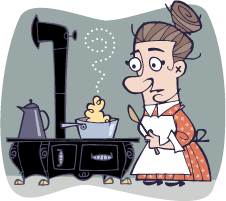
Some people like to say if your great grandmother wouldn’t recognize it as food, maybe it isn’t. How has what we eat changed since great grandma was slaving over a hot stove? Though, to see the total changes we need to go a bit further back than great grandma’s time, back to before the United States was born.
Top Ten Changes in the American Diet over the Last 250 Years
- Extracted vegetable oils from 0% to 7% of calories
- Twenty-fold increase in refined sugar
- More refined carbohydrates
- Fiber down by half
- Fruits and leafy vegetables eaten all year round instead of seasonally
- Pasteurized dairy products
- More lean muscle protein
- Less organ meats
- Less bone marrow
- Less saturated fat
Even the things that seem to be the same are different. Different hybrid strains of grains, different breeds of cattle and chicken, and less wild game.
If modern maladies like type 2 diabetes and heart disease are caused by modern diets, as many contend, why the obsession with saturated fat which has gone down? Meanwhile fiber has been cut 50%, refined sugar has increased 2,000% and extracted vegetable oils have increased… there is no percentage increase to calculate because it started at zero.
The dirty little secret about low-fat foods is what they do to make them palatable. Which is, they add sugar, usually corn syrup. One imagines any day now they’ll start putting “heart smart” labels on bags of sugar. Hey, it’s fat-free, right?
Filed 3/7/16

In the next exciting episode: Our hero bails-in the bank and to make up his loss, borrows the money back. Will Everyman survive Captain Keynes’ devious plot? Stay tuned!
Filed 3/2/16
Warm Puppies & Cool Cats
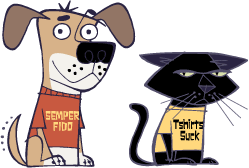
Do cats have Grinch-like five sizes too small hearts? Or is it that dogs are overdoing it? I mean, are people really all that lovable?
Moggies? Apparently that’s what Brits call house cats. They also seem to go in for long headlines. And don’t skimp on the URLs, either. Speaking of Englishmen speaking of cats and dogs, we have the following quote from Winston Churchill:
“I am fond of pigs. Dogs look up to us. Cats look down on us. Pigs treat us as equals.”
Filed 2/22/16
The Lone Eagle Takes on the Japanese Empire
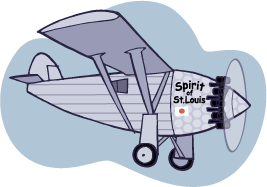
The most famous American flyer to shoot down an enemy aircraft in WWII was not an ace. He wasn’t even in the military. Not Claire Chenault of the Flying Tigers nor any of his pilots. It was Charles Lindbergh. That’s right, Lucky Lindy.
On a tour of U.S. Army Air Corps bases in southeast Asia in 1944, Lindbergh offered advice on how pilots could decrease fuel usage and increase the range of the gas-guzzling P-38 Lightning. After all, he knew a thing or two about squeezing every last drop of fuel for long distance flying. Air crews were skeptical so Lindbergh offered to accompany sorties flying a P-38 himself using his techniques.
The Lone Eagle flew 50 combat missions and shot down one Japanese plane, a Mitsubishi Ki-51 “Sonia.” When news of this hit the newswires Washington was none too pleased that such a prominent world celebrity, and a civilian, was going in harm’s way and so Lindbergh’s fighting career was ended soon after. By following his methods the P-38’s range was almost doubled which had a greater effect than his combat flying ever could.
28 July 1944, Civilian Charles Lindbergh Gets into Air Combat
Filed 2/15/16
Unreal Reality TV
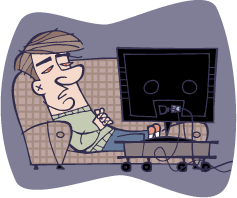
Some reality TV shows that aren’t a reality:
Hell’s Kitten Henpecked husbands try their feeble best to maintain a shred of manhood. Hosted by Gorgon Ramsey.
This Old Souse Quartet of plaid-clad New Englanders rehabilitate upper-class winos and posh drunks even if it means scooping out the innards and replacing vital organs in toto. Runs twelve weeks, one step per episode.
The Amazing Rat Race Teams compete for eight hours daily running a cubicle maze, looking busy, and hiding from supervisors. Prize for the winners: they get to do it all again tomorrow.
Survivor: Jeckyl Island Two tribes, Harvard and Yale, compete to see who can distort markets the most and blame capitalism when it crashes to earth. How big can too big to fail get before it’s the biggest and failiest ever? Stay tuned.
Beer Factor Contestants vie to see how many beers it will take to get them to do really stupid and dangerous things: dance on tables, pick a fight with a biker, eat a bar egg pickled in 1954. The ultimate challenge: drive home.
Who Wants to be a Nonprofit Millionaire? Charity organizers compete by raising awareness and donations for a cause du jour while pocketing the most in executive pay and advisory fees. Unlike similar shows, because it’s in the name of a worthy cause, no questions asked.
Extreme Do-over: Home Edition Contractors with sense and a modicum of taste correct the over-the-top, “I’ve got a theme” home “improvements” perpetrated on the beneficiaries of Ty Peddington’s maniacal makeovers.
Bigger Brother Everyday activities observed and recorded at work and home round the clock by government agencies. Starring, well, everybody these days.
Filed 2/11/16
Aussie, Aussie, Aussie, I-Yie-Yie
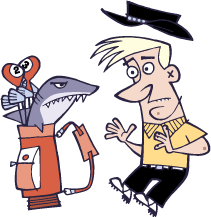
Above is an old spot I did for Fortean Times about someone in Australia finding a shark in a golf course sand trap. Rather lends a new meaning to hazard, eh? Still, while your average Aussie needn’t fear sand sharks as a rule, the Land Down Under is full of some of the most dangerous critters you’ll find, though one imagines you’d just as soon rather not find them. Or have them find you.
Australia's dangerous animals:
the top 30
Filed 2/10/16
All About And and & and &c.

In ye olden days, before 1950, there was no separate typewriter key for an exclamation point, called a slam in publishing jargon. (Perhaps people were less excitable then and so didn’t need it so often.) On the earliest typewriters an exclamation point was a three step operation: period, backspace, apostrophe. Or you could type the apostrophe first, either way it was three steps.
Nowadays we set off paragraphs with extra leading, a return, and/or indenting. In days gone by, as in before movable type when books were written with quill pens by scribes in candle-lit carrels (the original cubicle), they used that paragraph symbol. You know, the thingy that shows up when you show text invisibles: ¶ They stuck in this pilcrow, that’s what it’s called, wherever needed in the middle of a line, no return. Which they mightn’t have called a return because I think that’s a typewriter term, as in carriage return.
One guesses to most an ampersand is shorthand for ‘and’ and nothing more. You don’t see it much anymore, but it was used for et cetera, as &c. Then again, et cetera means ‘and so on.’ (Latin: et, and + ceteras, the rest) So etc. is ‘and’ in a way. In some type faces the & doesn’t look like a backward script S, which I think is it what it came from, but more resembles a ligature of Et which makes &c look like Etc.

To the Screen Writers Guild there’s a difference between ‘and’ and ‘&’ in film credits. ‘And’ is used when writers worked separately on a script, while ‘&’ means writers collaborated on it.
Filed 2/9/16
Death Be Not Proud, It Be Mortifyin’
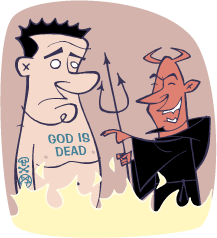
mortify (môr′ tə fī) verb. 1. Cause (someone) to feel embarrassed, ashamed, or humiliated. 2. Subdue (the body or its needs and desires) by self-denial or discipline. 3. Archaic, (of flesh) be affected by gangrene or necrosis.
Derivation: from late Middle English (in the senses ‘put to death,’ ‘deaden,’ and ‘subdue by self-denial’); from Old French mortifier, from ecclesiastical Latin mortificare ‘kill, subdue,’ from mors, mort- ‘death.’
So, death-ify to mortify. As in embarrassed to death, humiliated to no end, ashamed as hell. Or in the toon, mortified to death to no end in Hell with a capital H, which rhymes with… uh… does H rhyme with anything? Never mind. To return to the word under scrutiny, when you know the derivation you’ll see that old bit of art from the Suck archives fits to a nicety.
Filed 1/30/16
Words That Mean the Opposite of Themselves
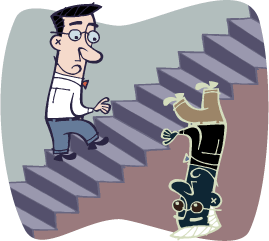
contronym (kŏn′ trə nĭm) noun. A word with two opposite meanings.
A contronym is an antonym of itself, as for instance cleave (divide) and cleave (adhere) or left (went) and left (remaining). Left seems some kind of Schrödinger’s word conveying both being there and not being there. Then you can cleave a chicken into left and right, eat the left and have the right left, right? One imagines contronyms are words someone of George Carlin’s bent would have plenty of fun with.
Then we have the contronyms: trim, oversight, sanction… Rather than my retreading the wheel, I’ll just redirect you to the source:
25 Words That Are Their Own Opposites
Filed 1/20/16
One Fine Day in the Classroom…
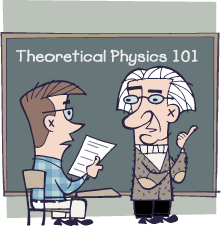


Above is interactive joke number two. Click on the pic and they talk.
I’ve heard that in the first year of medical school they tell students, “Half of what you will learn is either wrong or will be useless within ten years of graduation. The problem is, we don’t know which half.”
Which makes me wonder, what about all the other fields of study? Or is now the one time in history where we have the right answers for nearly everything? Other than for medicine, that is.
Filed 1/15/16
The Previous End of the World

A whole lot of pretty bizarre stuff happened in the fourteenth century. Folks didn’t understand it then, we don’t truly understand it now. The once accepted plague from black rats is largely discounted these days. Here’s an alternative hypothesis to entertain, it came from space. Is that possible? I have no way of knowing.
One thing I do know, I was able to repurpose an old Suck art spot. What do you know, the lazy plan works.
The Hundred Years War, the Fires of Tamatea and 1348 AD
Filed 1/12/16
Je Ne Sais Quoi
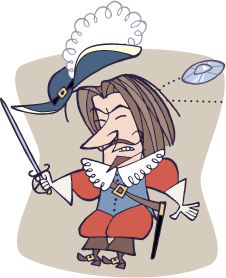
If I said “swashbuckler” you’d likely as not conger up images of those dashing French swordsmen, the Three Musketeers. Though why musketeers are renowned for prowess with the blade and not musketry is another question. Still, in every Hollywood extravaganza featuring the trio none have ever buckled a swash or swashed a buckle. Where did the term come from, anyway? I hear myself ask.
The buckler bit has nothing to do with our swaggering heroes being festooned with buckles on fancy belts, tall boots, jaunty plumed hats or whatever. The first part of the word refers to pretty much what you might expect, a sound effect; as in swish, swoosh, swash. Like the sound of a metal disc swung through the air. Which is what a buckler was; a small, round, metal dueling shield popular in the 1500s. A sort-of steel, self-defense Frisbee.
So a swashbuckler was someone who wielded a buckler, with some panache we assume. Though panache more aptly applies to their rakish hats. Panache, as a noun, is a plume of feathers.
A buckler, like many shields, had a single central handle with a round protuberance covering the hand. This bulge was called a boss. Thus, such a shield with this raised surface bump was… embossed. If you’re not sure what a buckler is or how it was used, check out the video:
A Discussion on Swords, Bucklers and Shields in Historical Fencing
Filed 1/7/16
Why Not Start the New Year with an Old Book?
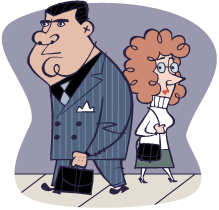
“He looked as if Nature had intended to make an ape, but at the last minute changed its mind.”
The above being Bertie Wooster’s description of Roderick Spode from one of the Wooster and Jeeves stories penned by the inimitable, hilarious P.G. Wodehouse. The joy of these tales is not merely the absurd vicissitudes inflicted on the oblivious Bertie and the clever way the ultimate English gentleman’s gentleman, Jeeves, saves his British bacon. No, indeed. The proceedings are narrated in goofball Bertie’s upperclass nitwit fashion, which is half the fun. An example from Very Good, Jeeves:
Baring a dentist’s waiting-room, which it rather resembles, there isn’t anything that quells the spirit much more than one of these suburban parlours. They are extremely apt to have stuffed birds in glass cases standing about on small tables, and if there is one thing which gives the man of sensibility that sinking feeling it is the cold, accusing eye of a ptarmigan or whatever it may be that has had its interior organs removed and sawdust substituted.
Another excerpt from The Code of the Woosters:
I can well imagine that the casual observer, if I had confided to him my qualms at the idea of being married to this girl, would have raised his eyebrows and been at a loss to understand. ‘Bertie.’ he would probably have said, ‘you don’t know what’s good for you,’ adding, possibly, that he wished he had half my complaint. For Madeline Basset was undeniably of attractive exterior – slim, svelte, if that’s the word, and bountifully equipped with golden hair and all the fixings.
But where the casual observer would have been making his bloomer was in overlooking that squashy soupiness of hers, that subtle air she had of being on the point of talking baby-talk. It was that that froze the blood.
With winter well and truly here you couldn’t do better than curling up with a good Bertie and Jeeves book and taking a delightful romp in the long-passed, funnier world, that never really existed, of the British upper crust at play.
Filed 1/2/16